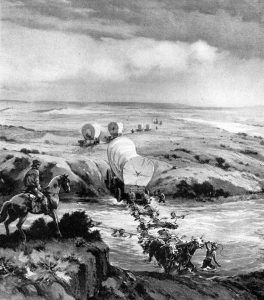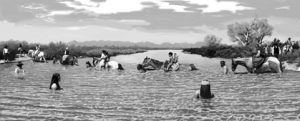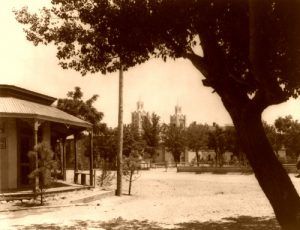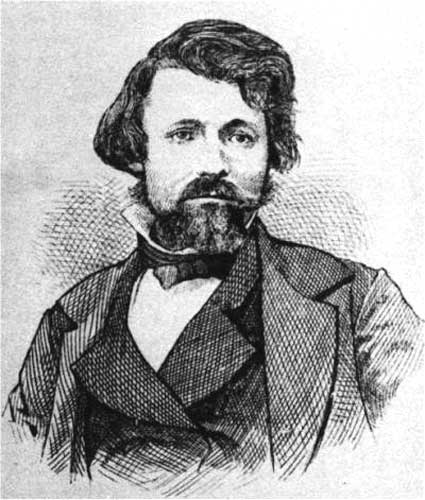
Francis Xavier Aubry
Francois Xavier Aubry was a French Canadian merchant, wagon train captain, and explorer of the American Southwest. His achievements include speed records riding the Santa Fe Trail and early exploration of the 35th parallel northwest of the North American continental divide.
Aubry was born on a farm near Maskinonge, Quebec, Canada, on December 3, 1824, to Joseph and Magdeleine Lupien Aubry. At the age of 18, he moved to St. Louis, Missouri, where he took a job as a store clerk. He soon learned of the profitability of hauling goods along the Santa Fe Trail. The young entrepreneur saved money to purchase several wagons and draft animals and got a loan for trade goods.
On May 9, 1846, the 21-year-old Aubry left Independence, Missouri, with a trader’s caravan, making his first trip along the Santa Fe Trail. After selling his goods in Santa Fe, New Mexico, he made enough money to repay his loans. The following year he moved to Independence to work full-time as a trader on the Trail.
Aubry soon decided that speed was the key to maximizing his profit and began making two annual trips along the trail instead of the customary single trip per year. On December 22, 1847, he left Santa Fe, and despite being harassed by Indians and adverse winter weather, he reached Independence in only 14 days, beating the previous record by 10½ days. Afterward, he received much publicity in the nation’s press, causing newsmen to dub him “Telegraph” Aubry.
Aubry continued to look for ways to increase his speed further and, in 1848, made three trips between Independence and Santa Fe. He made the journey on one trip in just five days and 16 hours, breaking his record, winning $5,000 in wagers, and earning the name “Skimmer of the Plains.”
By 1849 Aubry was one of the leading frontier merchants, believing that Chihuahua, Mexico, and Texas showed promise as trading venues. In February, he traveled to Chihuahua, via El Paso, Texas, along with another merchant named Charles White. Aubry and Charles White established a new mercantile in El Paso at some point. After they wholesaled their goods, Aubry returned to Independence, Missouri, on August 23. Along the way, his caravan had been attacked by both Apache and Pawnee. Still, they suffered no losses, and Aubry immediately purchased goods for a return trip to Santa Fe.
During the summer of 1849, Santa Fe Trail traffic had been grave for several wagon trains, many had been attacked, or their stock was driven off. The turmoil prompted Santa Fe Indian Agent James Calhoun to request more troops on August 15, noting that “the Indians, generally, are in a bad temper — the number of troops is insufficient here to keep up on them a proper check.”
Though he heard about the danger, Aubry was determined to make another trip. Leading a large caravan that included ten wagons owned by Ceran St. Vrain and 13 wagons owned by James White, they departed Westport, Missouri, on September 15. At some point along the trail, Aubry decided to send his wagon master, William Calloway, ahead to Santa Fe for fresh mules. James White, who considered himself “a trail veteran,” decided to go with him to get his family to Santa Fe more quickly. Aubry argued against this idea, but James was determined. He loaded his wife, Ann, daughter, Virginia, an employee named Ben Bushman, and a black nursemaid into two carriages. They were accompanied by a German traveler named Lawberger and two of Aubry’s Mexican employees.
The smaller caravan in the lead was attacked near the Point-of-Rocks along the Cimarron Cutoff in New Mexico on October 24. In what is known as the White Massacre, the warriors killed all the men, sparing only Ann White, her child, and her servant, who they took as captives.
Aubry reached Santa Fe on October 30, and when he heard the news of the attack and kidnapping, he offered $1000 for their release and promptly hired both Pueblo Indians and New Mexican friends to rescue the captives. Later, Ann White was killed, and the daughter and nursemaid were never found.
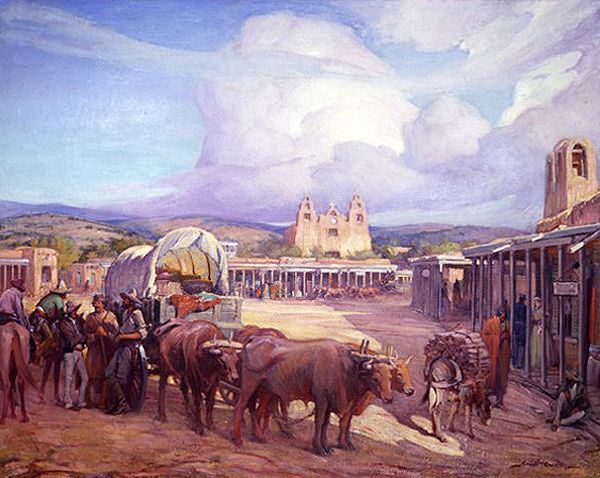
The Santa Fe Trail ends in Santa Fe, New Mexico.
Aubry then made Santa Fe his permanent home to continue to explore the potential market in Chihuahua, Mexico. Seeking to bypass the expense of goods purchased in Missouri, he left Santa Fe on December 1, 1849, with 20 empty wagons, crossed Texas, where he purchased goods in Victoria, and then proceeded to Chihuahua via El Paso. He returned to Santa Fe in early June 1850. Although this new route was financially rewarding, it proved to be difficult. Aubry ran into a severe snowstorm during the journey and lost 40 mules in one night, and Indians made the frontier especially dangerous. He would make the trip only one more time in 1850. Afterward, he wrote to the Daily Missouri Republican from San Antonio, Texas, admitting that Indian problems in Texas were so severe and distances so great that the San Antonio-El Paso Road could not replace the St. Louis-Santa Fe route. The Republican specified other problems, including the Chihuahua market glut, the shortage of grass and water, and “the class of whites known as gamblers, horse thieves and cutthroats.”
In late 1850, Aubry discovered an alternative to a portion of the Cimarron branch of the Santa Fe Trail that reduced the distance to travel by 52 miles and provided access to more water. This detour became known as the “Aubry Cutoff.”
In 1852, Aubry’s attention turned to California when he decided to take a caravan down the Rio Grande and Gila Rivers. He proceeded to San Francisco via Tucson and Los Angeles, arriving with 3500 sheep, 100 mules, and ten wagons of supplies.
After selling his goods, he, ten Americans, six Mexicans, and a black cook, began to make their way back to New Mexico. Returning along a different route, the party crossed the Tejon Pass on July 10, 1853, before reaching the Colorado River on July 23. They then crossed Arizona’s central mountains, where they began to be harassed by Indians (probably Yuman or Mohave). On August 14, an Indian chief feigning friendship approached Aubry’s campsite. However, the Indians’ manner changed quickly, and they attacked the Aubry party, injuring nearly every member. However, Aubry and his men fought off the Indians with their pistols, killing 25 attackers and wounding others in the process. Following this, the party continued to fight skirmishes with the hostile natives until they reached the Zuni Pueblo in New Mexico on September 6.
After returning to Albuquerque, Aubry reported on his journey to New Mexico Territorial Governor David Meriwether, writing, “I am satisfied that a railroad may be run almost mathematically direct from Zuñi to Colorado [river], and from thence to the Tejon pass in California.”
In late 1853, Aubry prepared to make a second trip to California with the assistance of other Santa Fe businessmen. Driving some 50,000 sheep, he reached Los Angeles on January 10, 1854, before proceeding to San Francisco. They left San Jose, California, on July 6 with a group of 60 men and arrived in Albuquerque, New Mexico, on August 18 without incident.
On the day of his return to Albuquerque, Aubry went to a store operated by the Mercure brothers to buy a drink on August 18. He ran into Richard Hanson Weightman, a former Territorial Delegate to the United States Congress and editor of Albuquerque’s Amigo Pais. Weightman had published an article with which Aubry had disagreed, and an argument arose between the pair, which escalated to violence. Aubry drew his gun, but it misfired, and Weightman stabbed him with a knife. Weightman was arrested on murder charges but was acquitted when it was decided he had acted in self-defense.
Aubry was just 29 and buried in Santa Fe’s Rosaria Cemetery.
Aubry’s diary was discovered in his saddlebags after his death, and accounts of his final journey were published in newspapers from St. Louis to New York. This spawned the railroads’ interest, and eventually, the Atlantic and Pacific Railroad was built chiefly along the route that Aubry had explored.
© Kathy Alexander/Legends of America, updated June 2023.
Also See:
Aubry Cutoff of the Santa Fe Trail
Early Traders on the Santa Fe Trail
Santa Fe Trail – Highway to the Southwest
White Massacre on the Santa Fe Trail
Sources:

